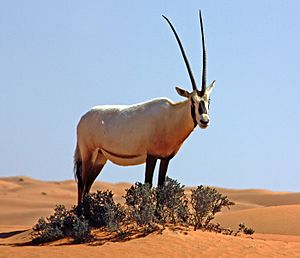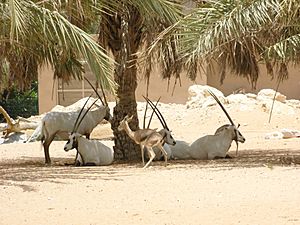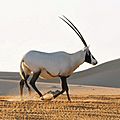Arabian oryx facts for kids
Quick facts for kids Arabian oryx |
|
|---|---|
 |
|
| An Arabian oryx in Dubai Desert Conservation Reserve, the UAE | |
| Conservation status | |
| Scientific classification |
The Arabian oryx or white oryx (Oryx leucoryx) is a type of antelope. It has a noticeable bump on its shoulder, long, straight horns, and a tail with a tuft of hair. This animal is the smallest member of the Oryx family. It naturally lives in the deserts and dry areas of the Arabian Peninsula.
Sadly, the Arabian oryx became extinct in the wild by the early 1970s. This means there were no more left in their natural habitat. However, thanks to zoos and special reserves, they were saved. Starting in 1980, these oryxes were brought back into the wild.
In 1986, the Arabian oryx was listed as endangered. This means it was at high risk of becoming extinct. But in 2011, it made history! It was the first animal to improve its status from "extinct in the wild" to "vulnerable". This means it's still at risk, but much less so. About 1,220 Arabian oryxes live in the wild today, and 6,000 to 7,000 are in captivity around the world.
A Qatari oryx named "Orry" was the official mascot for the 2006 Asian Games in Doha. You can even see its picture on the tailfins of Qatar Airways planes! The Arabian oryx is also the national animal of Oman.
Contents
What's in a Name?
The scientific name Oryx leucoryx comes from ancient Greek words. Oryx means "gazelle" or "antelope," and leukos means "white." So, its name basically means "white antelope." In English, it's also called the white oryx. In Arabic, it has names like maha and wudhaihi.
A scientist named Peter Simon Pallas first used the name "oryx" for these animals in 1777. Later, other scientists sometimes got confused between the Arabian oryx and another type of oryx called the scimitar oryx. For a while, the Arabian oryx was even called Oryx beatrix! But eventually, it got its original name back.
Appearance and Body

An Arabian oryx stands about 1 meter (3.3 feet) tall at the shoulder. It weighs around 70 kilograms (150 pounds), which is about the same as a person. Its coat is a bright, almost glowing white. Its undersides and legs are brown. It also has black stripes on its head, like where its head meets its neck, on its forehead, nose, and from its horns down to its eyes and mouth.
Both male and female oryxes have long, straight, or slightly curved horns. These horns have rings on them and can be 50 to 75 centimeters (20 to 30 inches) long.
Arabian oryxes usually rest during the hottest part of the day. They can sense rainfall from far away and will travel towards it to find fresh plants. This means they can cover huge areas. A group in Oman might travel over 3,000 square kilometers (1,160 square miles)!
Herds are made up of both males and females. They usually have between two and 15 animals. Sometimes, much larger groups of up to 100 have been seen. Arabian oryxes are generally peaceful with each other.
Besides humans, wolves are the only natural predators (hunters) of the Arabian oryx. In captivity (like in zoos) and safe wild areas, they can live up to 20 years. But during droughts, they might not live as long because of lack of food and water. Other dangers include fights between males, snakebites, diseases, and even drowning during floods.
Where They Live
Historically, Arabian oryxes lived across most of the Middle East. In the early 1800s, you could find them in places like the Sinai, Palestine, Iraq, and most of the Arabian Peninsula.
However, during the 19th and early 20th centuries, their numbers dropped. By 1914, only a few were left outside of Saudi Arabia. By the mid-1930s, the only groups left were in the Nafud Desert and the Rub' al Khali desert in Saudi Arabia.
In the 1930s, Arabian princes and oil company workers started hunting Arabian oryxes. They used cars and rifles, and some hunts involved as many as 300 vehicles. This led to a huge decline in their numbers. The last Arabian oryx seen in the wild before they were brought back was in 1972.
Arabian oryxes prefer to live in gravel deserts or hard sand. In these areas, their speed and endurance help them escape from most predators and hunters.
Today, Arabian oryxes have been brought back to Oman, Saudi Arabia, Israel, the United Arab Emirates, Syria, and Jordan. Small groups were also introduced to Hawar Island in Bahrain, and larger groups live in Qatar and the UAE. The total number of reintroduced oryxes is now around 1,000. This success helped them move from "extinct in the wild" to "vulnerable" on the conservation list.
How They Live
What They Eat
Arabian oryxes mostly eat grasses. But they also enjoy a wide variety of plants, including buds, herbs, fruit, tubers (like potatoes), and roots. Herds of oryxes will follow rainfall to find new plants that grow after the rain. They can even go for several weeks without drinking water! Studies in Oman show they especially like Stipagrostis grasses. The flowers of these plants have lots of protein and water.
Their Behavior
When Arabian oryxes are not moving around or eating, they dig shallow holes in soft ground under bushes or trees to rest. They can sense rain from far away and will travel towards new plant growth.
The size of a herd can change a lot, but usually, there are 10 or fewer animals. Sometimes, up to 100 have been seen! Male oryxes don't usually live alone, and single males with territories are rare. Herds have a clear pecking order, which includes all females and males older than about seven months.
Arabian oryxes like to keep an eye on other members of their herd. Younger males often stay between the main group and the females on the edges. If they get separated, males will look for the last place the herd was seen. If they can't find them, they will live alone until the herd returns.
Where there is enough water and good grazing, male Arabian oryxes will claim their own territories. Single males who are not part of a herd usually live alone. The animals show who is in charge by using body language and displays. This helps them avoid serious fights, which could be dangerous with their long, sharp horns. Both males and females use their horns to protect their territory and its resources from other animals.
Why They Are Important to Humans
The Arabian oryx is a very important animal in the Middle East. It is the national animal of Jordan, Oman, the United Arab Emirates, Bahrain, and Qatar.
Many businesses in the Arabian Peninsula are named after the Arabian oryx, like Al Maha Airways and Al Maha Petroleum. "Al Maha" is an Arabic name for the oryx.
In some old texts, like the King James Version of the Bible, the word re’em was translated as 'unicorn'. In modern Hebrew, the Arabian oryx is sometimes called re'em laban, meaning "white oryx."
The Unicorn Myth
The old myth of the one-horned unicorn might have come from oryxes that had lost one of their horns. Ancient thinkers like Aristotle and Pliny the Elder believed the oryx was the "original" unicorn. From certain angles, an oryx can look like it only has one horn. Since their horns are hollow bone and don't grow back, if an oryx loses a horn, it will only have one for the rest of its life.
Another idea is that the myth came from the translation of the Hebrew word re'em into the Greek word monokeros, which means "one horn." In some old writings, the word for "horn" is written in the singular. The Arabic word alrim is very similar to the Hebrew re'em and also means "white oryx."
Saving the Arabian Oryx

The Phoenix Zoo and the Fauna and Flora Preservation Society of London (now Fauna and Flora International), with help from the World Wildlife Fund, are famous for saving the Arabian oryx. In 1962, these groups started the first captive-breeding program for oryxes at the Phoenix Zoo. This project was sometimes called "Operation Oryx".
They started with just nine animals. Since then, the Phoenix Zoo has had over 240 successful births! From Phoenix, Arabian oryxes were sent to other zoos and parks to start new herds.
In 1968, Sheikh Zayed bin Sultan Al Nahyan of the UAE was worried about the wildlife in his country, especially animals like the Arabian oryx. So, he founded the Al Ain Zoo to help protect them.
By 1972, Arabian oryxes were completely gone from the wild due to hunting. But by 1980, there were enough oryxes in captivity that they could start bringing them back to their natural homes. The first release happened in Oman, with oryxes from the San Diego Wild Animal Park.
Even though numbers in Oman have gone down a bit, there are now wild groups in Saudi Arabia and Israel. One of the largest groups lives in the Mahazat as-Sayd Protected Area in Saudi Arabia. This is a huge, fenced reserve that covers more than 2,000 square kilometers (770 square miles).
In June 2011, the Arabian oryx's conservation status was changed to "vulnerable" by the IUCN Red List. This was a big step! In 2016, it was estimated that over 1,200 Arabian oryxes lived in the wild. Another 6,000 to 7,000 are kept in zoos, preserves, and private collections around the world. This was the first time the IUCN had ever changed a species' status from "extinct in the wild" to "vulnerable." The Arabian oryx is also listed in CITES Appendix I, which means it's protected from international trade.
However, on June 28, 2007, Oman's Arabian Oryx Sanctuary was removed from the UNESCO World Heritage List. This happened because the Omani government decided to open 90% of the site for oil exploration. The number of Arabian oryxes in that sanctuary dropped from 450 in 1996 to only 65 in 2007. Now, fewer than four breeding pairs are left there.
Images for kids
-
In Zoo Dvůr Králové, Czech Republic
-
Antelope Ranch, Yotvata Hai-Bar Nature Reserve, Israel
See also
 In Spanish: Órix de Arabia para niños
In Spanish: Órix de Arabia para niños






